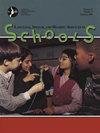Do Eyes Hear or Does the Mind Confuse? The Effect of Different Visual Conditions on Speech Perception in Noise in Children.
IF 2.9
3区 医学
Q1 AUDIOLOGY & SPEECH-LANGUAGE PATHOLOGY
Language Speech and Hearing Services in Schools
Pub Date : 2025-09-15
DOI:10.1044/2025_lshss-25-00053
引用次数: 0
Abstract
PURPOSE Understanding children's speech perception strategies in noise is very important for improving their living environment. Previous studies with adults reported that closing the eyes improves speech understanding in noise by increasing the activation of cortical systems involved in listening and attention, while increased cognitive load makes speech understanding in noise more difficult. This study aimed to investigate the effects of listening conditions on speech perception in noise in children. METHOD The study recruited 102 typically developing children, 51 girls and 51 boys, aged between 7 and 12 years with typical hearing. Speech intelligibility tests were performed in noise under three different conditions: eyes open (EO), eyes closed (EC), and watching cartoon (WC), which is assumed to increase cognitive load. All conditions were applied randomly (without any order in the conditions) to each participant. RESULTS In the speech intelligibility test in noise, the lowest signal-to-noise ratio (the best performance) was obtained in the EO, EC, and WC conditions, respectively. When EO-EC, EO-WC, and EC-WC were compared by the post hoc analysis, the largest effect size was obtained in EO-WC, EO-EC, and EC-WC, respectively. When evaluated in terms of genders, no statistically significant difference was found for the three listening conditions. CONCLUSIONS It has been shown that children's speech perception abilities in noise are affected at different levels by various factors such as open-closed eyes, auditory attention, and cognitive load. The best speech perception performance in noise was obtained in the EO condition, which is the natural situation.是眼睛听到了还是头脑混淆了?不同视觉条件对儿童噪声环境下言语感知的影响。
目的了解儿童在噪声环境下的言语感知策略,对改善儿童的生存环境具有重要意义。先前对成年人的研究报告称,闭上眼睛可以通过增加与听力和注意力有关的皮层系统的激活来提高对噪音中的言语理解,而增加的认知负荷会使对噪音中的言语理解变得更加困难。本研究旨在探讨不同听力条件对儿童噪音环境下言语感知的影响。方法本研究招募了102名典型发育儿童,其中女孩51名,男孩51名,年龄在7 ~ 12岁,听力正常。在噪声条件下进行了三种不同条件下的语音清晰度测试:睁眼(EO)、闭眼(EC)和观看卡通(WC),这被认为会增加认知负荷。所有条件随机应用于每个参与者(没有任何条件顺序)。结果在噪声条件下的语音清晰度测试中,EO、EC和WC条件下的信噪比最低(表现最佳)。通过事后分析比较EO-EC、EO-WC和EC-WC时,EO-WC、EO-EC和EC-WC分别获得最大的效应量。当以性别进行评估时,三种听力状况没有发现统计学上的显著差异。结论儿童对噪声的言语感知能力不同程度地受到睁眼、听觉注意、认知负荷等因素的影响。在自然状态下,在噪声条件下的语音感知性能最好。
本文章由计算机程序翻译,如有差异,请以英文原文为准。
求助全文
约1分钟内获得全文
求助全文
来源期刊

Language Speech and Hearing Services in Schools
Social Sciences-Linguistics and Language
CiteScore
4.40
自引率
12.50%
发文量
165
期刊介绍:
Mission: LSHSS publishes peer-reviewed research and other scholarly articles pertaining to the practice of audiology and speech-language pathology in the schools, focusing on children and adolescents. The journal is an international outlet for clinical research and is designed to promote development and analysis of approaches concerning the delivery of services to the school-aged population. LSHSS seeks to advance evidence-based practice by disseminating the results of new studies as well as providing a forum for critical reviews and meta-analyses of previously published work.
Scope: The broad field of audiology and speech-language pathology as practiced in schools, including aural rehabilitation; augmentative and alternative communication; childhood apraxia of speech; classroom acoustics; cognitive impairment; craniofacial disorders; fluency disorders; hearing-assistive technology; language disorders; literacy disorders including reading, writing, and spelling; motor speech disorders; speech sound disorders; swallowing, dysphagia, and feeding disorders; voice disorders.
 求助内容:
求助内容: 应助结果提醒方式:
应助结果提醒方式:


